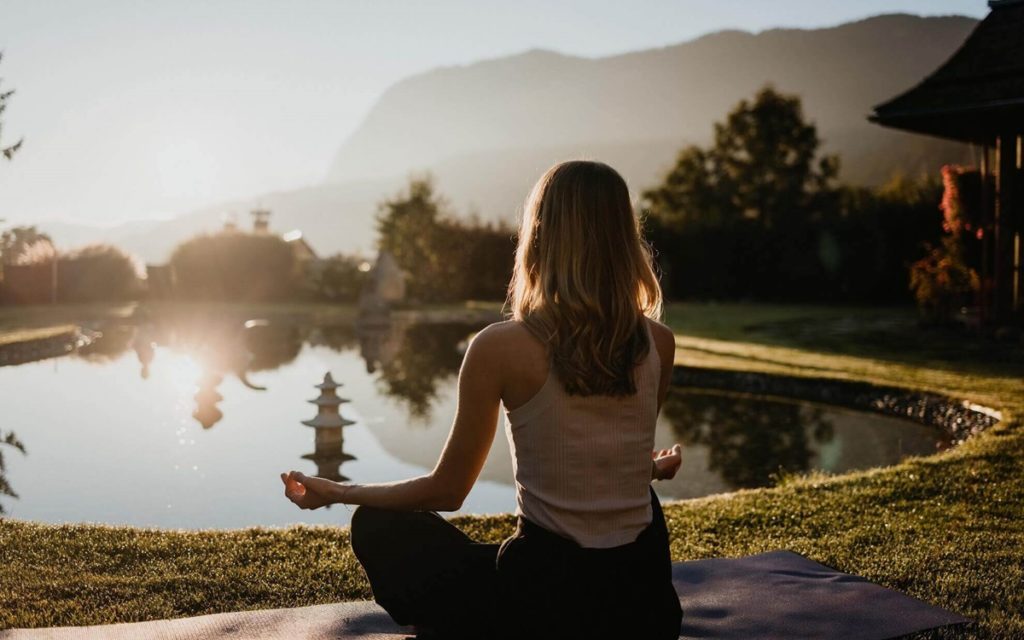In Ayurveda, meditation has long been a proven means of living more calmly and consciously. The beauty of it is that no special knowledge is required, because anyone can learn to meditate! Here we will show you a few simple meditation exercises that you can try out as a meditation beginner. Just give it a try and you're sure to find something that suits you!
Learning to meditate with exercises: How do you meditate properly?
The most important thing first and foremost: take it easy! Meditation takes practice and nobody becomes a meditation expert from one day to the next. And that's not even necessary. The main thing is that you calm your mind and find inner peace - and that you feel comfortable doing so.
The aim of meditation is to find mental peace, reduce stress and increase well-being. Especially in our hectic everyday lives, we often miss out on pausing and feeling ourselves. So take the time to reconnect with your mind and body and bring them back into harmony.
It is completely normal that your thoughts will often wander at first during the meditation exercises. The more you practise, the easier it will be for you to fully engage in meditation. Here we give you a few tips on how to get started with meditation.
7 tips for your first meditation exercises
To ensure that you feel comfortable while meditating, you should make your surroundings as cozy as possible. Try to satisfy your physical needs, such as hunger or thirst, before the meditation exercise so that you can start in peace.


- Choose a suitable place where you feel comfortable and won't be disturbed. You can also light a scented candle or incense.
- Take enough time to calm down. You should also plan a few minutes after the meditation before you return to your everyday life so that the meditation has its full effect.
- Wear comfortable clothing in which you can sit well.
- Find a comfortable position. Depending on the type of meditation, you can sit, lie on your back or even stand.
- Feel free to try out different exercises. If certain meditation exercises do you good and are fun, stick with them. If not, simply try something else.
- Meditate in small, regular intervals at the beginning. A few minutes a day is enough to start with. After that, you can increase step by step.
- Be kind to yourself and recognize that every step in your development is good and important. Observe, but don't judge yourself.
Feeling comfortable while meditating - everyone has a different idea of what that means. Find out for yourself what you feel comfortable with and keep trying out new things!
6 meditative exercises for beginners: instructions and explanations
Fortunately, there are many different meditation exercises that you can try out. That's why we'll show you a few exercises here that you can easily try at home as a beginner.
We will explain why the technique might be suitable for you and give you step-by-step instructions. You can try them all or simply start with the meditation exercise that appeals to you the most. It's entirely up to you.
1. mantra meditation: meditation exercises for beginners
A mantra meditation is a good start for anyone who finds it difficult to concentrate and wants to calm their mind. But even if you have a specific goal in mind that you want to achieve, you can make a mantra out of it and incorporate it into your meditation.
This is how it works:
Mantra meditation is very easy in principle. First choose a mantra that you can identify with. You can start with individual words such as calm or peace .
However, the mantra can also be something you want to achieve personally and consist of whole sentences such as: I open my heart to new things.
Once you have found your mantra, sit down and close your eyes. Now all you have to do is mentally repeat the mantra over and over again until your mind becomes calm and focused. If your thoughts wander, simply bring yourself back to your mantra.
2. walking meditation: reduce stress
If you feel restless and stressed and cannot imagine sitting still for long periods of time, you may find yourself in walking meditation. But even if you have to sit all day due to work, walking meditation can give you the balance you need.


This is how it works:
With walking meditation, the name says it all. All you have to do is consciously walk. Take one step at a time very slowly and deliberately.
Pay attention to your breathing and notice all the movements and sensations in your body. Feel the light breeze on your skin and the sensation of your foot hitting the ground.
Walk at this leisurely pace for a few minutes to calm down and leave disturbing thoughts behind you. Feel how you strip away stress with every step. Whether you are outdoors or simply walking up and down in your home is entirely up to you, because walking meditation works everywhere!
3. mindfulness exercises: Meditation exercise to fall asleep
This meditation is not only the basis for all mindfulness exercises, but also a very good introduction to meditative practices. If you find it difficult to wind down in the evening, a targeted mindfulness meditation can also help you to fall asleep better with Ayurveda.


This is how it works:
Lie comfortably in bed. Now listen to your breath and count each breath. As soon as you have reached 10, simply start again at 1, as this will take away the pressure of having to fall asleep.
Simply let any thoughts, feelings and sensations that arise pass by without holding on to them. Do not evaluate them and instead gently return to your breath again and again.
Meanwhile, you can go into your body and feel how your individual body parts spread out in bed and gradually become more and more relaxed. Soon your mind will calm down and you will gently drift off to sleep.
Tip: Do you have problems getting regular rest and balancing your sleep rhythm? The programs in the Sleep Well line can help you to fall asleep and stay asleep better.


Discover the European Ayurveda® Sleep Well Home Treatment now
Transform your sleep in just three weeks! This intensive Ayurveda program for at home can sustainably improve your sleep so that you can start the new day with full energy. Now with our European Ayurveda® Home App: The complete program for better sleep!
4. meditation with music: lifts the mood
Music not only reduces stress, but also lifts the mood. It is therefore particularly suitable for meditation. Meditation with music is ideal for you if you want to calm down and become more mindful at the same time. This meditation focuses on the experience of sound.
This is how it works:
Choose music that you like and that relaxes you. The style of music is entirely up to you. Everything is possible, from classical music to jazz and new age. However, we recommend that you start with instrumental music first.
Now sit down, breathe in and out deeply and concentrate exclusively on the music. Observe what the music does to you and what sensory impressions it triggers in you. You may even learn something about yourself in the process! In any case, you will become more relaxed and collected during the song.
5. visualization: journey to a place of power
Would you simply like to take some time out or would you prefer to go on a trip right away? With the conscious visualization of a place of power, you can mentally travel without moving from the spot. Thanks to this meditation exercise, you can withdraw whenever and wherever you are to let go and recharge your batteries.


This is how it works:
Imagine a certain place where you feel comfortable and can draw strength. It doesn't matter whether the place is real or only exists in your imagination. Let your imagination run wild and travel to a beach, a lakeside, a forest clearing or even a cozy library.
Now notice as many details of the place as possible. What sounds can you hear there? What does it smell like? Also pay attention to your breathing and feel how you are supplied with new life energy. If you feel strengthened and calmed, you can gently leave the place again.
The more precisely you imagine the place, the better the meditation exercise will work. This gives you your own personal place of power that you can return to anytime and anywhere.
6 Grounding: Finding your center again with meditation
If you have the feeling that everything is getting on top of you and you are looking for inner stability, you should try a grounding meditation. This will bring your body and mind back into harmony and give you new energy for everyday life.


This is how it works:
Sit down or lie on your back. Now imagine that roots are growing from your feet or your back. The roots slowly penetrate the ground beneath you and grow over several floors until they find fertile soil.
Now anchor yourself firmly to the ground and feel how the power of the earth flows through your body via the roots. Observe how you gradually absorb more energy and become calmer at the same time.
Finally, the roots leave the ground again and slowly return to your body - but the power of the earth remains with you.
What are the benefits of regular meditation exercises?
By meditating regularly, you can not only calm down and reduce stress, but also feel mental and physical changes. Mindfulness and meditation exercises have the following positive effects:
- You become calmer and more relaxed.
- You sleep better.
- You have more energy in everyday life.
- You can deal better with stress.
- You gain more self-confidence.
- You enjoy life more.
- You feel more gratitude and compassion.
- Your immune system is strengthened.
All our meditation exercises are perfect for beginners. And now it's time to try them out! You're sure to find a meditation technique that suits you and that you feel comfortable with. If you take enough time and are patient with yourself, you will also get off to a good start.


How can I regulate my nervous system? 4 tips from European Ayurveda®
An overstimulated nervous system is one of the most common causes of chronic complaints. Irritable bowel syndrome, exhaustion, hormonal imbalances, insomnia and migraines are common consequences. We show you how you can regulate your nervous system with European Ayurveda and get back into Vata balance.






